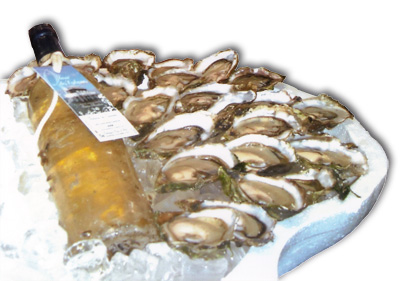Expérience France
Message in a bottle
Tuesday 23rd of June saw people arrive at the Vinexpo in droves to discover the results of an original experiment: the opening of bottles immersed for months at a depth of 8 meters in the Bassin d’Arcachon! For this first it was well worth inviting France’s Best Sommelier, Manuel Peyrondet, who temporarily neglected the “Bristol” in Paris where he has been working since April. Philippe Faure-Brac was also present, eager to taste the white Graves and the rums kept in the most unusual conditions. They were welcomed by the two initiators of the project, Franck Labeyrie, co-director of Château du Coureau in Haux and winegrower in Podensac and Virelade, and Dominique de la Guineraye, director of Rhums Clément in Martinique.

 Philippe Faure-Brac and Manuel Peyrondet.
Philippe Faure-Brac and Manuel Peyrondet.
 Manuel Peyrondet, Alain Delort (A.S.P.), Franck Labeyrie
Manuel Peyrondet, Alain Delort (A.S.P.), Franck Labeyrie
Château du Coureau
Labeyrie Père & Fils
33550 Haux
Tél : +33 (0) 5.56.23.05.03
Envoyer un mail
www.chateauducoureau.com
Rhum Clément
www.rhum-clement.com
Submerged maturing, an attractive project
What exactly is the concept? To immerge around 8000 bottles of wines and spirits for four months to study the impact of sea movements. Franck Labeyrie and Dominique de la Guigneraye decided to conduct this study within the framework of the Toulouse oenology faculty’s experimental protocol. Jean-Christophe Simon, was the oenologist in charge of the “scientific” follow-up. He analyzed the gustatory properties of the bottles that had been submerged under horizontal water pressure and ebb tides. Plastic sealing ensured water tightness and then the bottles were sealed in oyster bags for four months. The expectation was great as the bottles were lifted up and out the water on June 21st at the Cabanes Chanquet de La Teste (listed Unesco World Heritage Site).
Aromas of the sea?
Franck Labeyrie, initially inspired by the French documentary program, Thalassa, joined with other partners to submerge thousands of bottles of wine and spirits… and then to protect them from theft. The experiment is still continuing as according to Christophe Simon, “Four months is too short for an in-depth analysis. But it confirms what we already knew about the beneficial effects of a balance system on a wine’s roundness”. Dominique de la Guigneraye agrees, adding "The movement of the sea and thermal differences create a whole different universe. Rum gets a touch of iodine which it does not have naturally, giving it a completely different flavor from the traditional one.”

Manuel Peyrondet was the first to taste the two experimental bottles: a
Château du Coureau 2008 and a dark Rhum Clément, distilled from pure sugar cane. His impressions?
“In terms of experimenting with concentration and volume, audacity pays. This experiment brought together those passionate about oyster-farming and wine-making. The result is a new-style wine with marked aromatic flavors. From experience we already know that wines which mature in large, cool cellars have more panache than other wines. This could be the case here with iodized notes and the type of minerality sought after”.
A comparative tasting of Château du Coureau 2008 and Blanc des Cabanes by Manuel Peyronder, France’s Best Sommelier
“When submitted to organoleptic analysis, the wine reveals a slight salinity and also a vegetal, menthol note. In the mouth, the grape variety is less emphasized in the submerged sample but the wine is more subtle, has more sapidity and length. The first taste is just as vivid as with traditional wines, with the same freshness. The Sauvignon‘s exuberance is revealed (citrus, grapefruit, vetegal, boxwood…); the aromatic palette is more subtle, more mellow.” Christelle FAURE-NEMERY



